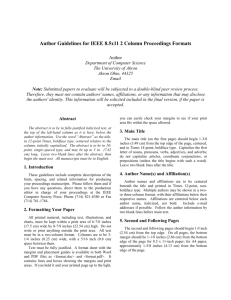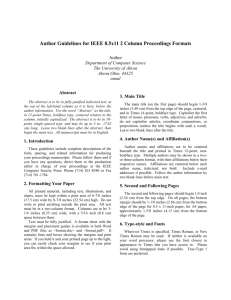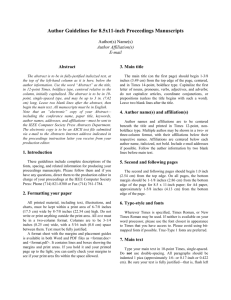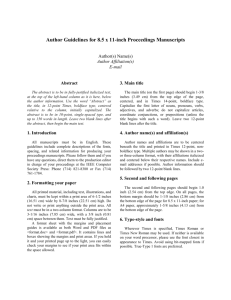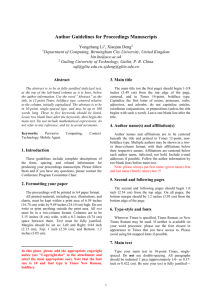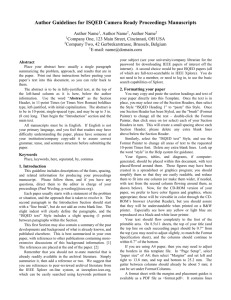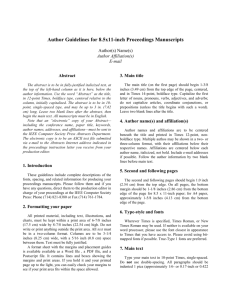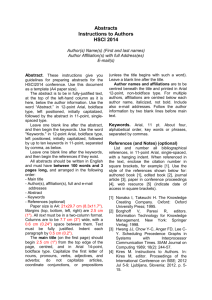docx
advertisement
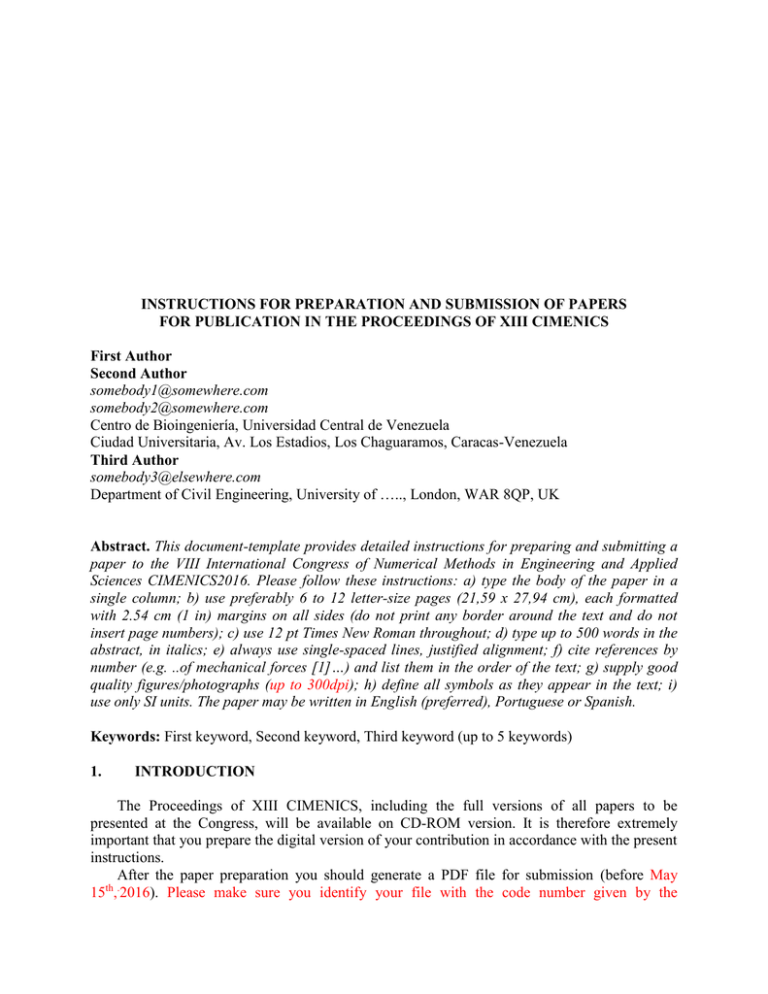
INSTRUCTIONS FOR PREPARATION AND SUBMISSION OF PAPERS FOR PUBLICATION IN THE PROCEEDINGS OF XIII CIMENICS First Author Second Author somebody1@somewhere.com somebody2@somewhere.com Centro de Bioingeniería, Universidad Central de Venezuela Ciudad Universitaria, Av. Los Estadios, Los Chaguaramos, Caracas-Venezuela Third Author somebody3@elsewhere.com Department of Civil Engineering, University of ….., London, WAR 8QP, UK Abstract. This document-template provides detailed instructions for preparing and submitting a paper to the VIII International Congress of Numerical Methods in Engineering and Applied Sciences CIMENICS2016. Please follow these instructions: a) type the body of the paper in a single column; b) use preferably 6 to 12 letter-size pages (21,59 x 27,94 cm), each formatted with 2.54 cm (1 in) margins on all sides (do not print any border around the text and do not insert page numbers); c) use 12 pt Times New Roman throughout; d) type up to 500 words in the abstract, in italics; e) always use single-spaced lines, justified alignment; f) cite references by number (e.g. ..of mechanical forces [1]…) and list them in the order of the text; g) supply good quality figures/photographs (up to 300dpi); h) define all symbols as they appear in the text; i) use only SI units. The paper may be written in English (preferred), Portuguese or Spanish. Keywords: First keyword, Second keyword, Third keyword (up to 5 keywords) 1. INTRODUCTION The Proceedings of XIII CIMENICS, including the full versions of all papers to be presented at the Congress, will be available on CD-ROM version. It is therefore extremely important that you prepare the digital version of your contribution in accordance with the present instructions. After the paper preparation you should generate a PDF file for submission (before May 15th,.2016). Please make sure you identify your file with the code number given by the Organizing Committee after abstract acceptance. For example, your file might be called CIM99999.PDF. The author(s) must pay the registration fee before June 17th,.2016 for the paper to be included in the proceedings of the congress 2. TYPING INSTRUCTIONS The paper must be written in English (preferred), Portuguese or Spanish. 2.1 Paper length The full paper including figures and tables should be preferably no longer than 12 lettersize pages (21,59 x 27,94 cm). Please limit your paper by writing concisely, rather than by reducing figures or tables to a size at which symbols/labels become difficult to read. The final PDF file should be smaller than 2 Mb. 2.2 Page format Each Letter-size page should be formatted with 25.4mm (1 in) margins on all sides. This defines the printable area for all pages (except the first page margin at the top is 80 mm). Inside this area, the text must be arranged in a single column. Please do not print any border around the text and do not insert page numbers. The final paper should look like this document. 2.3 General text specifications The paper must be typed using 12 pt Times New Roman throughout the text, as in the present document. This includes title, headings, figure and table captions. The first page must include the paper title, authors/affiliation, abstract and keywords. Paper title. Allow 80 mm margin space from the top, then type the first line of the title. The title should be in boldface type, all capital letters and centered on the page and must not exceed three lines. It should be single spaced if longer than one line. Skip one line (12 pt) between the title and the first author. Author(s) and affiliation. Type authors’ names in boldface type, flush left, one per line, including first name, middle initial and last name. Each name or group of names must be followed by the corresponding affiliation, which should be in regular type (neither boldfaced nor italicized). Skip two lines (24 pt) between the last affiliation and the abstract. Abstract and keywords. Type the heading Abstract. in boldface, flush left, followed by a period. On the same line, type the abstract in Times new roman 12, justified alignment. The abstract should be no longer than 500 words. Skip one line, then type the heading Keywords: (don't forget the colon) in boldface, flush left and type 3 to 5 keywords, separated by commas, with only the first letter of each keyword capitalized. Headings. Type a first-level head in all capital letters, boldface type, flush left. Begin by typing the Arabic number followed by a period, and then type the head title. Leave one blank line above and one below this head. For a second-level head, capitalize only the first letter, using boldface type, flush left. Begin by typing the double number and then type the sub-head title. Leave one blank line above and one below this head. Do not number third-level heads. Use boldface italics, capitalizing only the first letter and indenting 0.75 cm from the left margin. Follow it by a period and start the text immediately. Leave one blank line above this head. Body of text. The text should be typed using single-spaced lines and justified alignment. Start each paragraph 0.75 cm from the left margin and allow no space between paragraphs. 2.4 Equations, symbols and units Indent an equation center. Number it with an Arabic number enclosed in parentheses placed flush right. Allow one blank line above and one below an equation. For example: q r = 4π r 2 k dT dr (1) When referring to an equation in the text write "Eq. (1)," except at the beginning of a sentence, where "Equation (1)" should be used. Symbols should be italicized throughout the text. Define all symbols as they appear in the text. A nomenclature section is not necessary. All data, including those shown in tables and figures, must be reported in SI units. Decimal points rather than commas should always indicate decimals. 2.5 Figures and tables Figures and tables should be inserted as close as possible to their mention in the text. Enclosed text and symbols must be clearly readable; avoid small symbols. Use good quality pictures and illustrations. Figures must be professionally edited in a grayscale. Avoid light colors. Dark or patterned backgrounds may be unsuitable for reproduction. Figures should be inserted into the text and submitted (with de paper) in a separate TIFF files. Please submit at 300 dpi or higher. The final ZIP file containing pictures and illustrations should be smaller than 3 Mb Figures and tables and their captions should be centered in the text. Place figure caption below the figure and one blank line should be left between both. Place table title above the table, also leaving one blank line between them. Leave one blank line between the table or figure and the adjacent text. Table 1. Coefficients in constitutive relations Constitutive relation Turbulent tensor Nomenclature C Value 0.09 Turbulent tensor Lateral lift Virtual mass 0.69 0.08 0.8 Cb CL CVM Arabic numerals should be used in figures and tables (e.g., Figure 1, Figure 2, Table 1, Table 2). Refer to them in the text as “Table 1” and “Fig. 1” (except at the beginning of a sentence, where “Figure 1” should be used). 0 Pressure (N/m 2) -1000 Outlet section -2000 -3000 -4000 Symbols represent measured values -5000 0 20 40 60 80 Axial distance (mm) Figure 1- Pressure variation along the nozzle: experimental data. Label coordinates in plots and add the corresponding units. Similarly, label columns/rows in tables and add the units. 2.6 Permission You are responsible for making sure that you have the right to publish everything in your paper. If you use material from a copyrighted source, you may need to obtain permission from the copyright holder. References References should be cited in the text by name number. For example: "In a classical work of Mattiasson [2] …" References must be listed in the appearence order at the end of the paper. Type the word REFERENCES in all capitals, boldface type from the left margin, skip one line and type the reference list. In each reference, indent all lines 0.75 cm. Each reference must be cited in the text. Below, there is an example of a reference list including a book, a proceeding, a journal article, an edited book, and a dissertation. Acknowledgements This section should be positioned between the end of the text and the reference list. Type Acknowledgements in boldface italics, skip one line of space and type the text in regular type. REFERENCES [1]. Goossens, M., Mittelbach, F., & Samarin, A., The LaTeX Companion. Addison-Wesley, 1994. [2]. Mattiasson, K., Numerical results from large deflection beam and frame problems analysed by means of elliptic integrals. International Journal for Numerical Methods in Engineering, vol. 17, n. 1, pp. 145–153, 1980. [3]. Hinton, E., Sienz, J., & Afonso, S. M. B., Experiences with Olhoff’s ‘exact’ semianalytical algorithm. In Olhoff, N. & Rozvany, G. I. N., eds, First World Congress of Structural and Multidisciplinary Optimization (WCSMO-1), pp. 41–46, 1995. [4]. Ramm, E., Strategies for tracing the nonlinear response near limit points. In Wunderlich, W., Stein, E., & Bathe, K. J., eds, Nonlinear Finite Element Analysis in Structural Mechanics, pp. 63–89. Springer-Verlag, 1981. [5]. Sienz, J., Integrated Structural Modelling, Adaptative Analysis and Shape Optimization. PhD thesis, University of Wales/Swansea, 1994.
